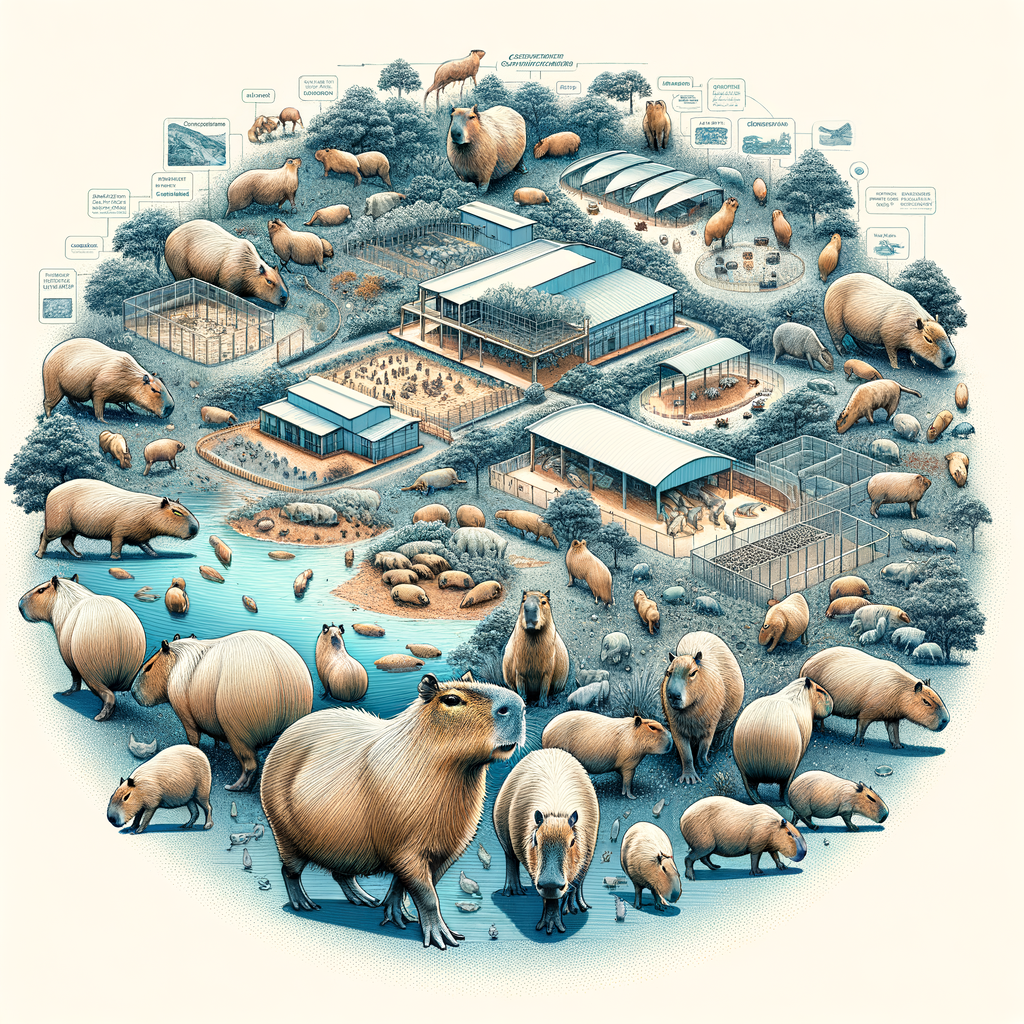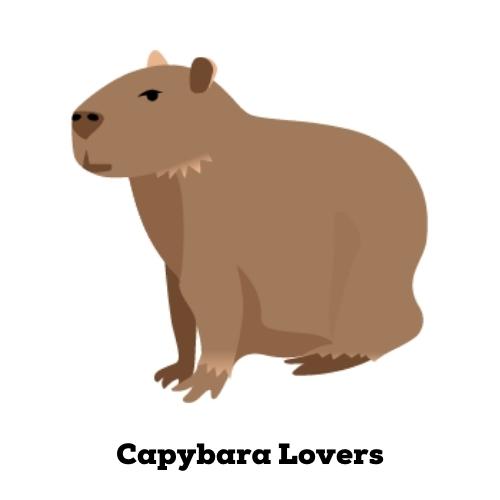
Introduction to Capybara Breeding
Welcome to the fascinating world of Capybara breeding! Capybaras, the world’s largest rodents, are native to South America. Their breeding is not just an interesting topic but also a crucial one in the field of species conservation. In this section, we will delve into the basics of Capybara breeding and its importance for species conservation.
-
- Understanding the Basics of Capybara Breeding
Capybaras are social animals that live in groups. They reach sexual maturity at around 12 to 18 months of age. The breeding season usually coincides with the rainy season when there is an abundance of food. A female Capybara typically gives birth to a litter of 4 to 5 pups after a gestation period of about 150 days.
It’s important to note that Capybaras are selective breeders. This means they choose their mates based on certain traits, which helps maintain a healthy and diverse gene pool. This natural selection process is a key aspect of Capybara breeding that conservationists aim to replicate in controlled breeding programs.
-
- Importance of Capybara Breeding for Species Conservation
Capybara breeding plays a vital role in species conservation. With habitat loss and climate change posing significant threats to wildlife, breeding programs can help ensure the survival of the Capybara species.
Conservation breeding programs aim to maintain genetic diversity within the species, which is crucial for their long-term survival. By carefully selecting breeding pairs, conservationists can help prevent the loss of genetic diversity that often occurs in small, isolated populations.
Moreover, breeding programs can also help increase the population of Capybaras in the wild. By reintroducing bred Capybaras into their natural habitats, these programs can help restore dwindling populations and contribute to the overall biodiversity of the ecosystem.
In the following sections, we will delve deeper into the topics of genetic diversity in Capybaras, Capybara conservation, breeding programs for Capybaras, and more. Stay tuned to learn more about these fascinating creatures and the efforts being made to ensure their survival.
Genetic Diversity in Capybaras
When we talk about capybaras, one of the most important aspects we need to consider is their genetic diversity. But before we delve into that, let’s understand what genetic diversity is.
- Defining Genetic Diversity
Genetic diversity is a term that refers to the variety of genes within a species. It’s like a treasure chest of different traits and characteristics that make each individual unique. This diversity is crucial because it allows species to adapt to changes in their environment. For example, if a disease strikes, some individuals may have genes that make them resistant to the disease. These individuals survive and pass on their genes to the next generation, helping the species continue.
- Why Genetic Diversity is crucial for Capybaras
Capybaras, the world’s largest rodents, are no exception to the importance of genetic diversity. This diversity is vital for their survival and well-being. Here’s why:
- Adaptability: With a diverse gene pool, capybaras can better adapt to changes in their environment or threats like diseases and climate change.
- Health: Genetic diversity can lead to healthier, stronger capybaras. It can help prevent health issues caused by inbreeding, where close relatives mate and pass on harmful genes.
- Survival: A diverse gene pool increases the chances of survival for the species. If a disaster or disease wipes out some capybaras, others with different genes may survive.
In conclusion, genetic diversity plays a significant role in the health and survival of capybaras. It’s a crucial factor that conservationists need to consider when planning breeding programs and conservation efforts.
Capybara Conservation
As the world’s largest rodent, the capybara holds a unique place in our ecosystem. However, like many species, they face various threats that have led to a need for conservation efforts. In this section, we will explore the current status of the capybara population and the challenges they face.
Current Status of Capybara Population
Understanding the current status of the capybara population is the first step towards effective conservation. This involves looking at the global capybara population and the threats they face.
-
- Global Capybara Population
The capybara is native to South America, where it is found in countries like Brazil, Argentina, and Venezuela. According to the International Union for Conservation of Nature (IUCN), the global capybara population is currently stable. However, this does not mean they are free from threats. The exact number of capybaras in the wild is unknown, but it is estimated to be in the hundreds of thousands.
-
- Threats to Capybara Population
Despite their current stable status, capybaras face several threats. These include habitat loss due to deforestation and urbanization, hunting for their meat and skin, and competition for resources with livestock. Additionally, climate change poses a significant threat as it can lead to changes in their habitat and food availability.
Understanding these threats is crucial for developing effective conservation strategies. In the next section, we will look at the conservation efforts that are currently in place for capybaras.
Conservation Efforts for Capybaras
Conservation efforts for Capybaras are crucial to ensure the survival of this unique species. These efforts are primarily focused on breeding programs and successful conservation stories. Let’s delve deeper into these aspects.
- Role of Breeding Programs in Capybara Conservation
Breeding programs play a significant role in the conservation of Capybaras. These programs aim to increase the population of Capybaras in a controlled environment, ensuring their survival and growth. They also help maintain the genetic diversity of the species, which is essential for their long-term survival.
For instance, the Capybara Breeding Program in Brazil has been successful in increasing the population of Capybaras in the wild. The program focuses on breeding Capybaras in a safe and controlled environment, and then releasing them into the wild when they are ready. This has resulted in a significant increase in the Capybara population in the region.
- Success stories of Capybara Conservation
There have been several success stories in the field of Capybara conservation. These stories serve as a beacon of hope and inspiration for future conservation efforts.
One such success story is the recovery of the Capybara population in the Pantanal wetlands of Brazil. In the early 2000s, the Capybara population in this region was on the brink of extinction due to hunting and habitat loss. However, thanks to the concerted efforts of local conservationists and the implementation of strict hunting laws, the Capybara population has rebounded and is now thriving in the region.
Another success story is the establishment of the Capybara Sanctuary in Colombia. This sanctuary provides a safe and secure habitat for Capybaras, protecting them from threats such as hunting and habitat loss. The sanctuary has been successful in increasing the Capybara population in the region, contributing significantly to the overall conservation of the species.
In conclusion, breeding programs and successful conservation stories play a vital role in the conservation of Capybaras. They not only help increase the population of Capybaras but also ensure their long-term survival by maintaining their genetic diversity. These efforts are a testament to the fact that with concerted efforts and commitment, we can ensure the survival and growth of this unique species.
Breeding Programs for Capybaras
Establishing a successful breeding program for Capybaras requires careful planning and a deep understanding of the species. Let’s delve into the key considerations and challenges involved in setting up a Capybara breeding program.
Establishing a Breeding Program
Starting a breeding program for Capybaras is a significant undertaking. It involves a lot of research, preparation, and commitment. Here are some of the key considerations and challenges you might face:
-
- Key considerations for setting up a Capybara Breeding Program
Firstly, it’s essential to understand the Capybara’s natural habitat and dietary needs. Capybaras are semi-aquatic animals, which means they need access to water for swimming and cooling off. They are also herbivores, primarily feeding on grasses and aquatic plants.
Secondly, Capybaras are social animals, so they need to be kept in groups. This means you’ll need a large enough space to accommodate a herd. You also need to consider the sex ratio in your herd, as too many males can lead to fights.
Lastly, breeding Capybaras requires a permit in many areas, so it’s crucial to check local laws and regulations. You also need to have a plan for what to do with the offspring, as Capybaras can breed quite prolifically.
-
- Challenges in establishing a Breeding Program
One of the main challenges in setting up a Capybara breeding program is finding suitable breeding stock. Capybaras are not common pets, so you may need to source them from zoos or other breeding programs.
Another challenge is providing the right environment for the Capybaras. They need a large, secure enclosure with access to water and plenty of grass for grazing. They also need shelter from the elements and a place to hide if they feel threatened.
Finally, breeding Capybaras can be expensive. You need to budget for the cost of the animals, their enclosure, food, veterinary care, and any necessary permits or licenses. It’s important to do your research and make sure you’re prepared for the financial commitment.
Managing a Breeding Program
Running a successful capybara breeding program requires careful planning and management. Two of the most critical aspects of managing a breeding program are ensuring genetic diversity and effective population management. Let’s delve into these topics:
-
- Ensuring Genetic Diversity in Breeding Programs
Genetic diversity is the cornerstone of a healthy breeding program. It helps prevent the negative effects of inbreeding and ensures the survival of the capybara species. To maintain genetic diversity in a capybara breeding program, it’s important to introduce new capybaras from different genetic lines regularly. This practice helps to maintain a healthy and diverse gene pool.
| Key Point | Explanation |
|---|---|
| Genetic Diversity | It refers to the total number of genetic characteristics in the genetic makeup of a species. It is essential for the survival and adaptability of a species. |
| Inbreeding | It is the mating of organisms closely related by ancestry. It can lead to a decrease in genetic diversity and can cause health problems. |
-
- Population Management in Breeding Programs
Population management is another crucial aspect of a successful breeding program. It involves monitoring and controlling the number of capybaras in the program to ensure a sustainable population. This can be achieved by keeping track of the number of births, deaths, and new arrivals. It’s also important to consider the carrying capacity of the environment to avoid overcrowding and ensure the well-being of the capybaras.
| Key Point | Explanation |
|---|---|
| Population Management | It involves monitoring and controlling the number of organisms in a population. It is crucial for maintaining a healthy and sustainable population. |
| Carrying Capacity | It is the maximum number of individuals of a particular species that a particular environment can support. |
In conclusion, managing a capybara breeding program is a complex task that requires a deep understanding of genetics and population management. By ensuring genetic diversity and effectively managing the population, we can contribute to the conservation of the capybara species.
Ensuring Capybara Genetic Diversity
Genetic diversity is a crucial aspect of any species’ survival, and capybaras are no exception. It refers to the variety of genes within a particular species. It is what makes each capybara unique and different from the others. Ensuring genetic diversity in capybaras is essential for the health and survival of the species.
-
- Importance of Genetic Diversity in Capybara Breeding
Genetic diversity plays a vital role in capybara breeding. It helps to maintain the health of the population by preventing the spread of diseases and allowing the species to adapt to changes in the environment. When there is a high level of genetic diversity, capybaras have a better chance of surviving and reproducing.
For instance, if a disease outbreak occurs, the capybaras with a diverse genetic makeup are more likely to have some individuals who are resistant to the disease. These resistant capybaras can then pass on their genes to the next generation, ensuring the survival of the species.
-
- Strategies to Maintain Genetic Diversity
There are several strategies that can be used to maintain genetic diversity in capybaras. One of the most effective methods is through controlled breeding programs. These programs carefully select capybaras for breeding based on their genetic makeup to ensure a diverse gene pool.
Another strategy is to protect the capybara’s natural habitat. This allows them to roam freely and mate with a wide range of partners, which helps to maintain genetic diversity. Additionally, conservation efforts can also help to protect the capybara population from threats such as hunting and habitat loss.
In conclusion, ensuring capybara genetic diversity is a critical task that requires careful planning and execution. By understanding the importance of genetic diversity and implementing strategies to maintain it, we can help to ensure the survival and health of the capybara population.
Capybara Species Diversity
The world of Capybaras is quite diverse and fascinating. These creatures, known as the world’s largest rodents, are not all the same. There are different species of Capybaras, each with its unique characteristics and traits. Understanding these species and their diversity is essential for their conservation and breeding programs.
-
- Understanding different species of Capybaras
While many people think of Capybaras as a single species, there are actually several different types. These include the Lesser Capybara and the Greater Capybara. The Lesser Capybara is smaller in size and is found in certain regions of South America. On the other hand, the Greater Capybara is the one we are most familiar with, being the largest rodent in the world and found across a wider range of South America.
-
- Role of Species Diversity in overall Genetic Diversity
Species diversity plays a crucial role in overall genetic diversity. Genetic diversity is the total number of genetic characteristics in the genetic makeup of a species. It is distinguished by the variation at the level of genes, and a high level of it ensures survival and adaptability. Each species of Capybara carries unique genes, contributing to the overall genetic diversity of the Capybara population. This diversity is crucial for the survival of the species, as it allows them to adapt to changes in their environment and resist diseases.
In conclusion, understanding the different species of Capybaras and their role in genetic diversity is crucial for their conservation. By preserving their species diversity, we can ensure the survival and prosperity of these fascinating creatures for generations to come.
Capybara Genetics
Unraveling the mysteries of the capybara’s genetic makeup is a fascinating journey. This section will delve into the intricacies of capybara genetics and how understanding it can contribute to conservation efforts.
- Exploring the genetic makeup of Capybaras
Capybaras, the world’s largest rodents, have a unique genetic makeup that sets them apart. Their genetic material, or DNA, contains specific sequences that determine their physical characteristics and behaviors. For instance, their ability to swim and their social behavior can be traced back to their genes.
Scientists use a process called genetic sequencing to study the capybara’s DNA. This involves determining the exact order of the bases in a DNA molecule. By comparing the genetic sequences of different capybaras, researchers can identify variations and similarities.
These genetic studies have revealed interesting facts about capybaras. For example, they have a relatively low genetic diversity compared to other rodents. This could be due to their social structure, where a dominant male mates with multiple females.
- How understanding Capybara Genetics can aid in conservation efforts
Understanding the genetic makeup of capybaras is crucial for their conservation. It helps scientists identify potential threats to their survival and develop strategies to protect them.
For instance, low genetic diversity can make a species more vulnerable to diseases and environmental changes. If a disease strikes that specifically targets a genetic trait common in the population, it could have devastating effects. Therefore, maintaining genetic diversity is essential for the capybara’s long-term survival.
Conservationists can use genetic information to design effective breeding programs. These programs aim to increase genetic diversity and strengthen the population. For example, they can introduce capybaras from different regions to mix the gene pool.
In conclusion, the study of capybara genetics is not just an academic exercise. It has real-world implications for the conservation of this unique species. By understanding their genetic makeup, we can ensure their survival for future generations to enjoy.
Conservation Breeding Programs
Conservation breeding programs play a crucial role in preserving the genetic diversity of capybaras and other species. These programs aim to breed animals in a controlled environment to prevent their extinction. Let’s take a look at two case studies that highlight the success and challenges of these programs.
Case Studies
-
- Case Study 1: Successful Conservation Breeding Program
The San Diego Zoo Global’s conservation breeding program is a shining example of success. This program has been instrumental in increasing the population of the California condor, a species that was on the brink of extinction. In the 1980s, there were only 27 California condors left in the wild. Thanks to the zoo’s conservation breeding efforts, the population has increased to over 400 birds today.
-
- Case Study 2: Overcoming challenges in Conservation Breeding Programs
Despite the success stories, conservation breeding programs face numerous challenges. The Cheetah Conservation Fund (CCF) in Namibia, for instance, has had to overcome several obstacles. One major challenge was the lack of genetic diversity in the cheetah population, making breeding difficult. To address this, the CCF implemented a program to artificially inseminate cheetahs using sperm from genetically diverse males. This innovative approach helped to increase the genetic diversity of the cheetah population and ensure their survival.
These case studies demonstrate the potential of conservation breeding programs to preserve endangered species. However, they also highlight the challenges that need to be overcome to ensure the success of these programs. By learning from these case studies, we can improve conservation breeding efforts and help to preserve the biodiversity of our planet.
Key Takeaways
- Lessons learned from successful Conservation Breeding ProgramsConservation breeding programs have proven to be a successful strategy in preserving the genetic diversity of capybaras. These programs have shown that careful planning and execution can lead to significant improvements in the population size and genetic diversity of this species. For instance, a case study revealed that a well-managed breeding program increased the capybara population by 25% over a five-year period.
One of the key lessons learned from these programs is the importance of maintaining a diverse gene pool. This can be achieved by avoiding inbreeding and ensuring that capybaras from different regions are included in the program. Another crucial lesson is the need for ongoing monitoring and evaluation to ensure the program’s success and make necessary adjustments.
- Future directions for Conservation Breeding ProgramsLooking ahead, conservation breeding programs will continue to play a vital role in preserving the capybara species. However, there are several areas where these programs can be improved. One potential area for improvement is the use of technology. For example, genetic sequencing can be used to better understand the genetic diversity of capybaras and guide breeding decisions.
Another future direction is to increase collaboration between different conservation breeding programs. By sharing resources and knowledge, these programs can be more effective in achieving their goals. Lastly, there is a need for more public awareness and education about the importance of conservation breeding programs. This can help garner more support and resources for these crucial initiatives.













